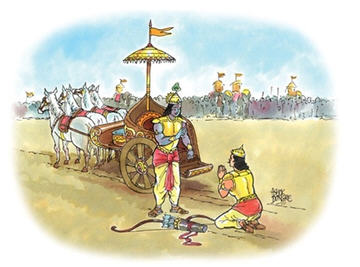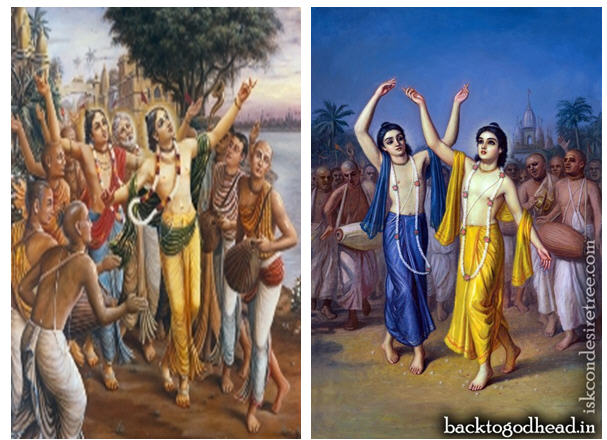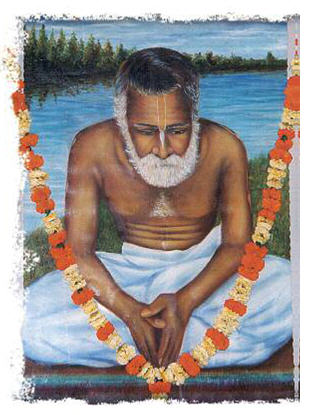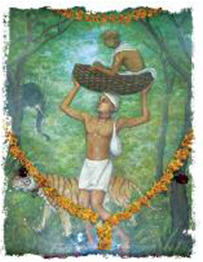Samudragarh is non-different from Dvaraka-puri. Both Dvaraka-puri and Ganga-sagara exist here. Many years ago there was a king, known as Samudra Sena, living here in Samudragarh. He was a great devotee of Lord Sri Krishna and did not know anything except the glories of Krishna. Once, Sri Bhimasena, one of the five Pandavas, came here with his soldiers to conquer Vanga-bhumi (Bengal). Bhimasena was roaming the earth to become the Digvijayi (conqueror of all directions). According to the established system, he would travel to various kingdoms, collecting tax from the rulers who would thus submit themselves to the rule of the Pandavas. If anyone refused to pay the tax he had to fight with Bhimasena. In order to conquer Vanga-bhumi, Bhimasena surrounded the country with his soldiers. King Samudra Sena was a great devotee of Lord Sri Krishna and had a strong desire to attain the Lord’s darsana. He then devised a plan to take advantage of the presence of Bhimasena to bring Krishna to his kingdom. He did not submit to Bhima by paying him the proper tax but rather chose to wage war. The king thought, “When Bhimasenais in trouble during the battle, and calls for Lord Krishna then the Lord, being the protector of His devotees, will come to rescue Bhimasena and thus I will receive darsana of Sri Krishna.” With this plan in mind, Sri Samudra Sena prepared his battalions to fight with Bhima. The king started shooting arrows furiously, in meditation on Lord Krishna. Feeling the force of the king’s arrows, Bhimasena became fearful and mentally prayed to Lord Krishna,
“Oh my Lord, kindly protect Your servant from this danger by giving me the shelter of Your lotus feet. I can no longer endure this fight with Samudra Sena and at the same time I can not tolerate abandoning the battlefield.O, merciful Lord! It is a great shame that the Pandavas, whose Lord is Sri Krishna, will be defeated.” By hearing the pitiful prayers of Bhima, Lord Krishna appeared on the battlefield, visible only to Samudra Sena. The king sawthe youthful form of the Lord, whose bodily color was like freshly formed clouds. A flower garland graced His neck, He wore a beautiful yellow dhoti and His entire body shone due to the magnificent array of jewellery He wore. When the king saw that most incredible form of the Lord, he immediately fainted, falling to the ground. When he regained his external senses he prayed to the Lord, “Oh, Krishna! You are the Lord of the universe, deliverer of the fallen living entities. You have come here to bestow Your mercy upon me, understanding me as one of the most fallen. The entire universe is glorifying Your wonderful pastimes. By hearing Your glories I developed a great desire to have Your darsana and made a vow to bring You to this Navadvipa-dhama as it was not possible for me to leave Navadvipa. O, most merciful Lord! In order to keep my vow, being merciful upon me, You have now appeared here in Your form as Sri Krishna. But I have another deeper, confidential desire. I wish to see Your Gauranga form manifest in front of me.”


Immediately, the king could see the incomparably sweet pastimes of Radha and Krishna. He saw Sri Krishna along with His sakhas, enjoying His go-carana (grazing the cows) pastime during the afternoon in Sri Kumudavana. After just one moment that pastime disappeared and he saw the most beautiful form of Gauranga. He was filled with bliss, seeing the Lord along with Hisassociates, chanting and dancing in maha- sankirtana. The Lord’s transcendental form was the color of molten gold, giving ecstatic pleasure to the eyes. The king felt blessed to behold that form and offered many prayers at the lotus feet of Lord Gauranga. After some time the scene disappeared from the vision of the king, who began weeping in separation. While all this was transpiring, neither Bhimasena nor anyone else could perceive it. Seeing the king crying, Bhima thought that he must have become afraid of the battle. The Pandava then gained courage and began to show his prowess in the fight. The king, being pleased by the efforts of Bhima, eventually submitted and offered to pay him the tax, leaving him to continue on his quest. This is the place known as Samudragarh which is the boundary or outer limit of Navadvipa-dhama. Even Lord Brahma does not know the glories of this place.


